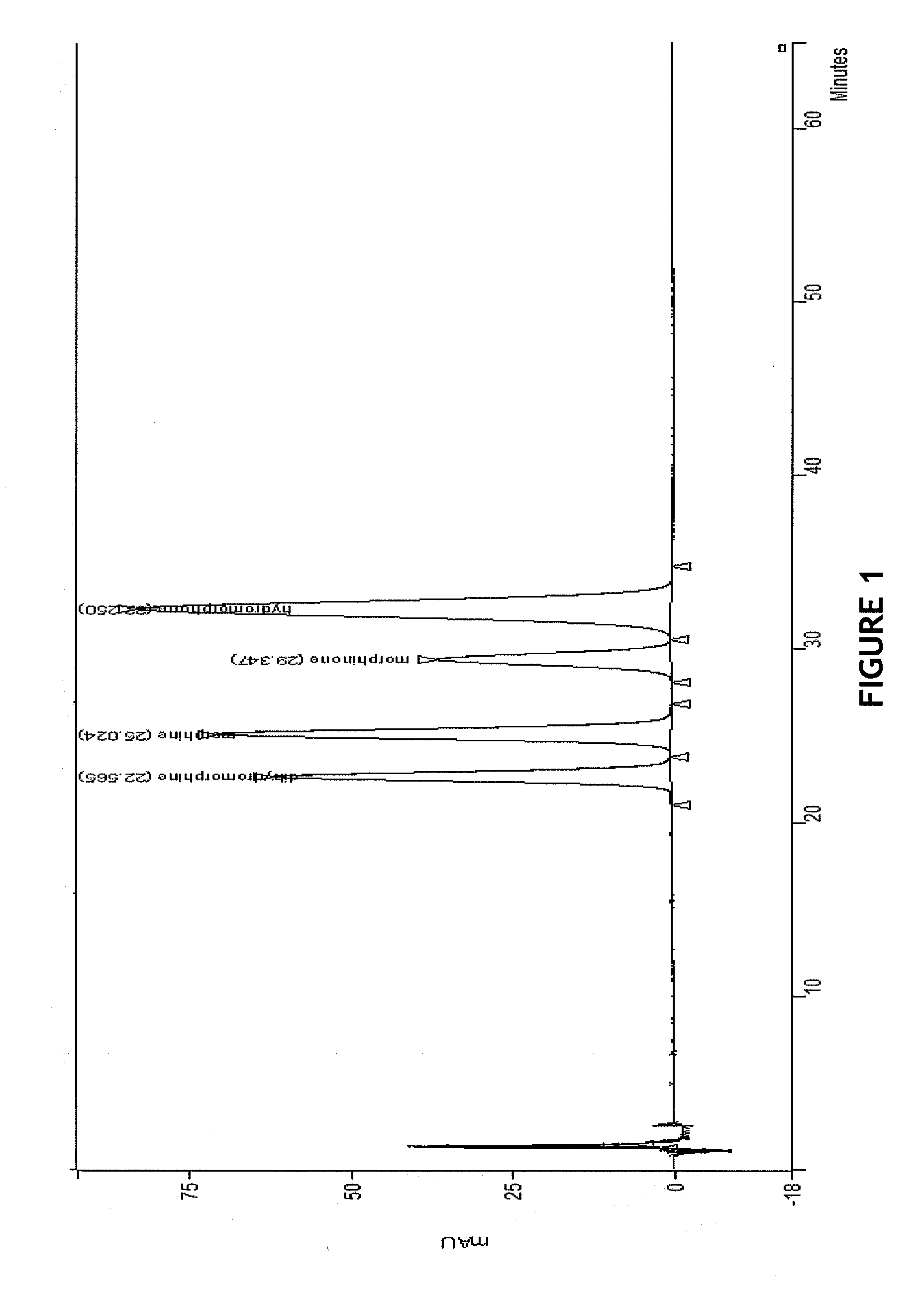HPLC method for separation and detection of hydromorphone and related opioid pharmacophores
a technology of hydromorphone and related opioid pharmacophores, applied in the field of hplc methods, can solve the problems of insufficient separation and detection techniques of isocratic hplc, failure to provide adequate separation of each of the four opioid pharmacophores from a mixture, and attempts at routine optimization utilizing standard hpl
- Summary
- Abstract
- Description
- Claims
- Application Information
AI Technical Summary
Benefits of technology
Problems solved by technology
Method used
Image
Examples
example 1
[0090]HPLC separation of dihydromorphine, morphine, morphinone and hydromorphone was performed via isocratic HPLC with a mobile phase utilizing ion-exchange processes coupled with reverse phase ion-pair chromatography reagent sodium docecyl sulfate (SDS).
[0091]Opioid samples were prepared in a semi-quantitative fashion for co-injection. The sample mixture contained dihydromorphine, morphine, morphinone and hydromorphone. Opioids as free bases were weighed individually and diluted to 10 mL with diluent (water, methanol, and acetic acid (HOAc: 95:5:1, v / v). As prepared, hydromorphone was 1.02 mg / mL, dihydromorphine was 0.33 mg / mL, morphine was 1.08 mg / mL, and morphinone 0.2 mg / mL. Aliquots were then qualitatitively combined at ˜25% / each into 1.5 mL autosampler vial for injections.
[0092]The mobile phase was prepared by combining sodium dodecyl sulfate (SDS, 60 g) with milliQ water (7200 mL) for a 28.9 mM SDS buffer solution. Next, a 50:50 organic blend of methanol:acetonitrile (1800 mL...
example 2
[0103]HPLC separation of dihydromorphine, morphine, morphinone and hydromorphone was performed with various SDS concentrations in the mobile phase. HPLC mobile phases were prepared with SDS concentration at 10 mM, 20 mM, 25 mM, and 50 mM SDS in aqueous portion of mobile phase. Otherwise mobile phase utilized 80:20 aqueous buffer (SDS, AcOH) / 50:50 organic, ACN:MeOH. Briefly, to a 1200 mL aliquot of the SDS concentration adjusted 80:20, buffer / organic solution mixture was added acetic acid (glacial, 20 mL), followed addition of sodium acetate (2.178 g). The mobile phase was degassed well until bubbles absent and all NaOAc fully dissolved. The pH was measured. Method parameters for Examples 2a to 2d are the same as described in example 1.
example 2a
[0104]A 10 mM SDS buffer solution was prepared and mobile phase pH was measured at 3.15. Use of 10 mM SDS resulted in peak broadening and increased k′ such that the four compounds did not completely elute before the end of the 60-minute run time. Data not shown.
PUM
| Property | Measurement | Unit |
|---|---|---|
| wavelength | aaaaa | aaaaa |
| wavelength | aaaaa | aaaaa |
| concentrations | aaaaa | aaaaa |
Abstract
Description
Claims
Application Information
 Login to View More
Login to View More - R&D
- Intellectual Property
- Life Sciences
- Materials
- Tech Scout
- Unparalleled Data Quality
- Higher Quality Content
- 60% Fewer Hallucinations
Browse by: Latest US Patents, China's latest patents, Technical Efficacy Thesaurus, Application Domain, Technology Topic, Popular Technical Reports.
© 2025 PatSnap. All rights reserved.Legal|Privacy policy|Modern Slavery Act Transparency Statement|Sitemap|About US| Contact US: help@patsnap.com



